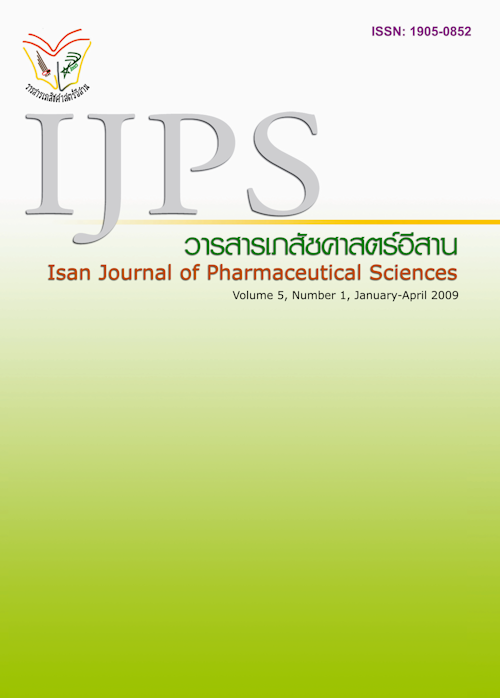Improving Accuracy of Drug Use in Visually Impaired Women by Using the Talking Label
Main Article Content
Abstract
This randomized controlled trial aimed to develop and assess the effectiveness of the talking label in improving accuracy of drug use in visually impaired women. We divided 32 visually impaired women at Sampran Rehabilitation and Training Center for Blind Women into 2 groups, 16 each. The study group received the talking label (pill box with specific voice explanation on detail of each drug, developed by the researchers). The control group received the normal label. The accuracy of drug use was measured 3 times by the correction of drug details to be taken at each meal answered by the subjects. In the 1st test, both groups received the normal label. At the 2nd and 3rd tests, the study group received the talking labels (earpiece version and speaker version respectively). At the 1st test, the study group showed lower overall accuracy of drug use than the control group, but it was significantly higher in the study group at the 3rd test (25.31±1.81 vs. 19.25±4.17; p < 0.001). There were no significant difference between the ear piece-and the speaker-talking labels. Satisfactions on the labels were also significantly higher in the study group (48.87±2.60 vs. 32.37±6.04; p < 0.001). In conclusion, the talking label can improve accuracy of drug use and it was very well accepted by the target group.
Article Details
In the case that some parts are used by others The author must Confirm that obtaining permission to use some of the original authors. And must attach evidence That the permission has been included
References
Albert SM, Weber CM, Todak G, et al. An observed performance test of medication management ability in HIV: Relation to neuropsychological status and medication adherence outcomes. AIDS Behav 1999; 3: p.121-128.
American Foundation for the Blind. Key finding: national poll on severe vision loss/blindness. [online]. [cited 2007 Oct 7]. Available from http://www.afb.org/seniorsite.asp?sectionD=68&TopicD=320&DocumentD=3376.
Anderson K, Jue SG, Madaras-Kelly KJ. Identifying patients at risk for medication mismanagement: using cognitive screens to predict a patient’ s accuracy in filling a pillbox. Consult Pharm2008; 23(6): p.459-472.
Brézin AP, Lafuma A, Fagnani F, et al. Prevalence and burden of self-reported blindness, low vision, and visual impairment in the French community. A nationwide survey. Arch Ophthalmol 2005; 123: p.1117-1124.
Business Wire. Talking label system helps visually impaired manage own prescription medication, Announces Zebra Technologies [Online]. 2000[cited 2009 March 20]. Available from http://findarticles.com/p/articles/mi_m0EIN/is_2000_Oct_2/ai_65639277.
Frick KD and Foster A. The magnitude and cost of global blindness: an increasing problem that can be alleviated. Am J Ophthalmol 2003;135: p.470-476.
Frick KD, Walt JG, Chiang TH, et al. Direct costs of blindness experienced by patients enrolled in managed care. Ophthalmology 2008; 115: p.11-17.
Grainger J and Hutchinson R. The costs of blindness: An analysis of the costs of visual impairment and blindness in the United Kingdom. [Online].2003 [cited 2007 Oct 7]. Available fromhttp://www.healthyeyes.org.uk/index.php?id=35.
Jin YP and Wong DT. Self-reported visual impairment in elderly Canadians and its impact on healthyliving. Can J Ophthalmol 2008; 43(4): p.407-413.
Németh G, Olaszy, Bartalis M, et al. Automated drug information system for aged and visually impaired persons. Computers Helping People with Special Needs. Lect Notes Comput Sci 2008; 5105: p.238-241.
OûConnor PM, Chou SL, Lamoureux EL, et al. Costs of vision impairment in childhood and youth: diary case studies. Optom Vis Sci 2008; 85(11): p.1106-1109.
Pasquale LR, Dolgitser M, Wentzl off JN, et al. Healthcare charges for patients with ocular hypertension or primary open-angle glaucoma. Ophthalmology 2007; 115(4): p.633-638.
Rahi J, Cumberland PM, Peckham CS. Visual impairment and vision-related quality of life inworking-age adults: findings in the 1958British birth cohort. Ophthalmology 2009; 116(2): p.270-274.
Talking Products Ltd. Talking Labels. [Online]. [cited2009 Mar 20]. Available from http://www.talkingproducts.co.uk/pdf/talking_labels.pdf.
Taylor HR, Pezzullo ML, Keeffe JE. The economic impact and cost of visual impairment in Australia. Br J Ophthalmol 2006; 90: p.272-275.
Wagner H, Fink BA, Zadnik K. Sex- and gender-based differences in healthy and diseased eyes. Optometry 2008; 79: p.636-652.
World Health Organization and International Agency for the Prevention of Blindness. State of the world’s sight. VISION2020: the right to sight1999-2005. Hyderabad, India: Pragati Offset Pvt; 2005.


